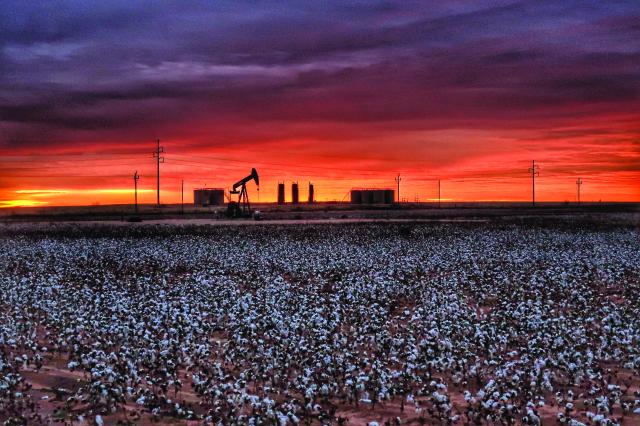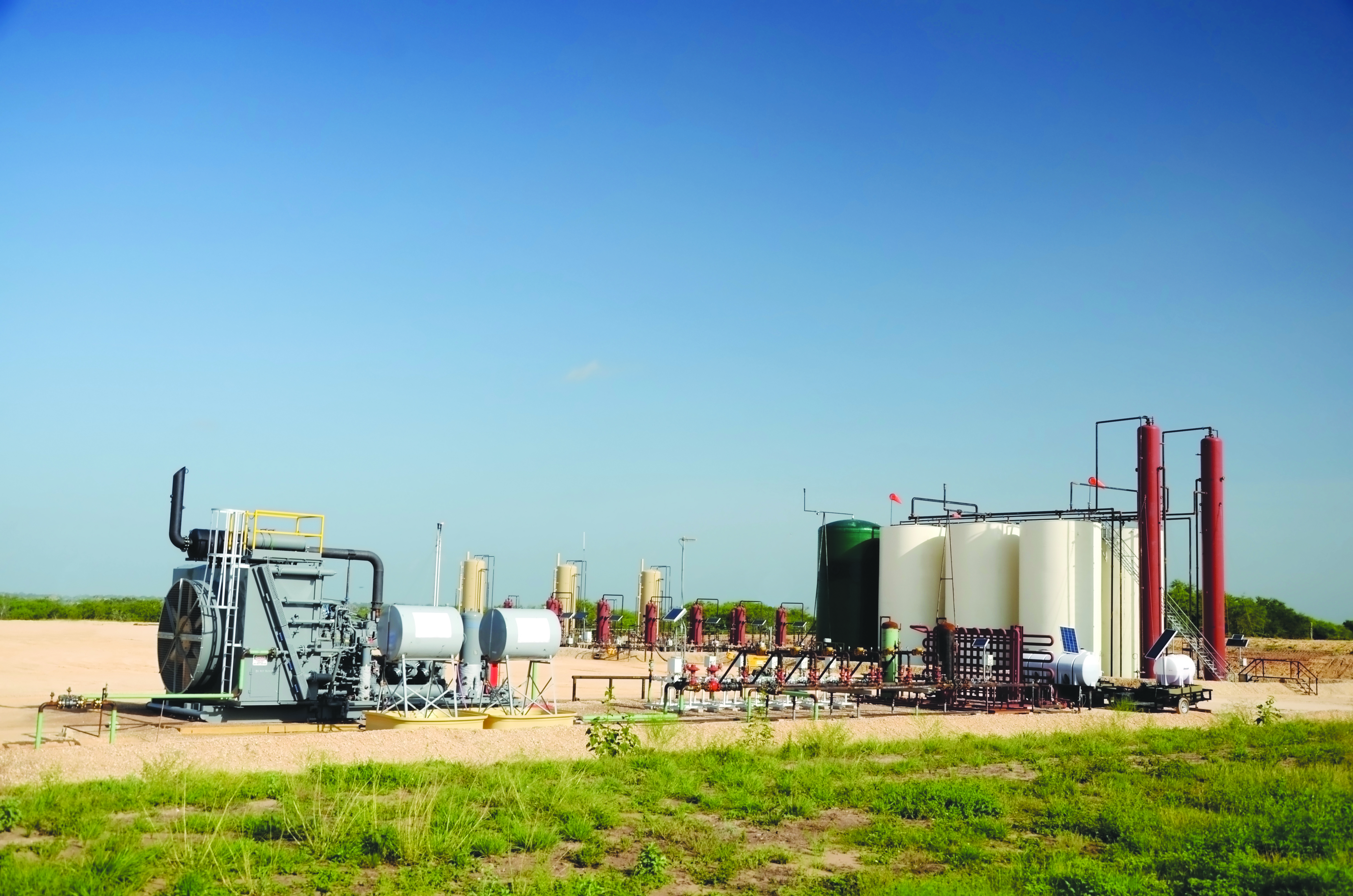
Rather than flare off unwanted natural gas, producers should use it to replace electricity to power artificial lift systems. (Source: GB Hart/Shutterstock.com)
Horizontal wells are a challenge to artificially lift. Horizontal unconventional wells are even harder to artificially lift. The basins that produce a lot of gas along with the oil and water are even more of a challenge to artificially lift, and sand complicates matters even more.
The first widespread drilling program of horizontal wells was in the Austin Chalk in Texas and Louisiana. These wells were not fractured, were completed in open hole and were normally pressured. They produced a good amount of gas and were predominantly lifted with gas lift. A modified multirate gas-lift design was used to follow a well’s production from the highest rate to depletion. These wells depleted slowly, so the designs worked efficiently for years. The compressors used on these wells were natural gas-driven.
Unconventional horizontal wells that are fractured produce a lot of gas and, as a result, also a lot of sand and water. Both of those cause serious problems with electric submersible pumps (ESP) and rod pumps. Most operators flow the wells back until the wells reach a rate when they need to be put on artificial lift. The typical artificial lift strategy for unconventional wells is to run an ESP as the first artificial lift method. ESPs can produce very large amounts of fluid, but they are very sensitive to sand and gas and typically have a short runlife.
ESPs are pulled when reaching the end of their usable lives, and gas lift is run as the second artificial lift method. Pumping unit salesmen have convinced operators that gas lift is not an efficient lift system below 500 bbl/d. Therefore, the third artificial lift change is made when the wells reach a rate where they have been deemed inefficient, and the gas lift is pulled and pumping units are run.
Pumping units do not like gas and sand either, but they are the most widely used method of artificial lift in the world. ESPs, like pumping units, also struggle with gas and sand, and modifications must be made to keep the ESP and pumping units running in unconventional wells. Gas lift does not need to be modified to work in these wells.
In all the major gas fields in the world, gas lift is the dominant artificial lift method used, while gas-fired compressors are the dominant source of energy used to power the gas-lift fields.
Flaring
On any night in shale basins around the world, the sky is lit up with flares to dispose of natural gas that cannot be transported to the market or otherwise used. It is a wasteful but safe way to dispose of the gas. The market for natural gas is nonexistent at a price that operators can afford to build the infrastructure to get the gas to market. For most operators, the only sensible option is to flare the extra natural gas.
Natural gas, like potable water, is a finite resource. Farmers in areas like the Texas Panhandle were once blessed with an overabundance of freshwater for many years, but they pumped water out of the ground to the point that today there is not enough water to irrigate the fields. Unfortunately, much of that water was wasted rendering the once prolific farms almost unusable today. This is where natural gas could be if the current practice is continued.
There is a simple answer to solve the issue of wasting natural gas. The answer is to stop using technology that is powered by electricity and power the lift systems with the overabundance of natural gas.
Gas-fired compressors
Most gas-lift fields around the world use gas-fired compressors to operate their gas-lift systems. These fields typically have vertical wells and produce a constant stream of fluid and gas. When there is a steady stream of gas, the compressors run with no issues.
Unconventional horizontal wells produce slugs of fluid and gas. When a well produces slugs of fluid and gas, the well does not deliver a steady stream of fuel gas to the compressor. Without a steady stream of gas, the compressors will not run continuously.
This problem first presented itself to the gas-lift industry in the 1980s when the Austin Chalk wells headed terribly. Many conversations and meetings were had to try to solve this issue and, luckily, a solution was uncovered rapidly.
Slugging in horizontal wells is the natural flow regime. Fluid, sand and gas separate as they travel down the lateral section of a horizontal well. When the fluid reaches the heel of the well, it begins to travel up to the vertical section of the well. As the fluid and gas turn the corner and reach 15 degrees to 45 degrees, gravity takes over and the fluid falls back onto itself into a turbulent flow pattern.
It stays there until enough pressure builds up and pushes the slug of fluid to the surface. This cycle typically takes 15 minutes to 45 minutes to complete. During that buildup cycle, no fluid or gas are flowing to the surface. When there is no gas flowing to the surface, the gas-fired compressor shuts down. If an elaborate recirculation system is built on the surface, then the compressor will continue to run. This is expensive and still does not guarantee gas will be available at the surface.
A simple method was developed in the early days of the Austin Chalk’s existence when operators began to run tailpipe below the packer. This tailpipe had to be long enough to ensure that the end of the pipe was laying on the bottom of the lateral so that fluids, sand and gas would remix. The gas helps push the fluids and sand around the corner and to the surface. The heading is not completely stopped, but the slugging is slowed enough to keep the compressors running on the produced gas. The problem is solved, and gas lift using gas-fired compressors remains a popular practice in the Austin Chalk.

High-rate gas lift
Unconventional wells can produce incredibly large amounts of fluid that many might say must be produced with an ESP. That is false. Gas lift, when properly configured, can produce rates up to 70,000 bbl/d. To achieve such rates, the well must have the ability to deliver rates that high and the tubing and casing must be designed to produce at these rates. In addition, compressors must be built to deliver more injection gas at higher pressures. Engineers must think out of the box, challenge conventional wisdom and come up with new design methods to achieve the rates desired. The knowledge is out there to do all these things, but much of it has left the industry.
High-rate gas lift comes in many flavors:
• Conventional tubing flow in 27⁄8-in. tubing and up with up to 4,000 bbl/d on gas lift;
• Annular flow with conventional tubing inside casing with up to 8,000 bbl/d;
• Single-point gas-lift annular and tubing flow with up to 6,000 bbl/d;
• High-rate annular flow using a hollow rod inside the casing with up to 25,000 bbl/d; and
• Higher rates can be achieved, but well conditions severely limit these wells from making up to 70,000 bbl/d.
Medium-rate gas lift
An unconventional well’s production rates decline faster than any other type of oil well. An unconventional well can produce 8,000 bbl/d one day, then drop to 3,000 bbl/d very rapidly. When an unconventional well depletes at such a rate, any artificial lift design becomes inefficient.
A high-rate design for a well producing 8,000 bbl/d routinely drops to a much lower rate like 3,000 bbl/d. At that point, it must be changed to efficiently lift the lower rate whether it is on gas lift or an ESP. A gas-lift system can easily be configured to produce from 3,000 bbl/d down to 300 bbl/d to 500 bbl/d at which time most operators shift to pumping units. That move is very expensive and uses electricity.
Other nonelectric lift options
Another option is to install a multirate gas-lift design that will produce from 3,000 bbl/d through depletion. One of the more popular nonelectric options is to set a tubing stop with a bumper spring above the operating gas-lift valve. A big bypass plunger is dropped into the well and the well is put on gas-lift assisted plunger lift (GAPL).
Another system is velocity gas lift, which combines gas lift with a velocity string to lift the well to depletion. Velocity gas lift will work in many tubing size combinations and lowers the injection gas and pressure needed to lift the well. Velocity gas lift can produce as much as 500 bbl/d inside of 27⁄8-in. tubing. The orifice using this lift type can be set at the total vertical depth of the well. Velocity gas lift will lower the bottomhole pressure lower than any other form of gas lift. This type of lift is not suitable for use in a well that produces iron sulfate and paraffin.
Gas-fired generators also are available. Pumping units, ESPs and other forms of artificial lift can be powered by these generators. Gas and sand will shorten the life of either of these systems.
Conclusions
Electricity is not needed to lift an unconventional well at any time in the life of the well. When planned correctly, a well can be placed on high-rate annular lift, then switched to conventional gas lift and then to GAPL or velocity gas lift with minimal tubing pulls.
Plunger-assisted gas lift (PAGL) can produce as much as 1,000 bbl/d in the right well, while a velocity gas-lift system can produce a well to depletion with less gas and pressure needed to do so. PAGL, GAPL and velocity gas-lift types use less gas than regular gas lift. A smaller compressor can be installed to save money.
Gas is a valuable resource that must be conserved for future generations. Using electricity requires the expenditure of two fuel sources: one to generate the electricity and the second to power the lift system. Gas lift uses very little gas and conserves gas for future generations.
Check out the other "2019 Permian Playbook" chapters that appeared in the October issue of E&P magazine:
OVERVIEW:
Produced Water, Well Interference Challenge Growth in the Permian Basin
KEY PLAYERS:
Permian Operators Delivering Strong Production
TECHNOLOGY:
New Technology Primed and Prepped For Permian Challenge
MIDSTREAM:
Long-Haul Capacity from the Permian Close to Pulling Even with Production
Changing Paradigm of the Permian
PRODUCTION FORECAST:
Permian Poised to Deliver Strong Oil and Gas Production Growth
CASE STUDIES:
Producing Unconventional Wells without Electricity
Recommended Reading
BP Restructures, Reduces Executive Team to 10
2024-04-18 - BP said the organizational changes will reduce duplication and reporting line complexity.
Matador Resources Announces Quarterly Cash Dividend
2024-04-18 - Matador Resources’ dividend is payable on June 7 to shareholders of record by May 17.
EQT Declares Quarterly Dividend
2024-04-18 - EQT Corp.’s dividend is payable June 1 to shareholders of record by May 8.
Daniel Berenbaum Joins Bloom Energy as CFO
2024-04-17 - Berenbaum succeeds CFO Greg Cameron, who is staying with Bloom until mid-May to facilitate the transition.
Equinor Releases Overview of Share Buyback Program
2024-04-17 - Equinor said the maximum shares to be repurchased is 16.8 million, of which up to 7.4 million shares can be acquired until May 15 and up to 9.4 million shares until Jan. 15, 2025 — the program’s end date.





